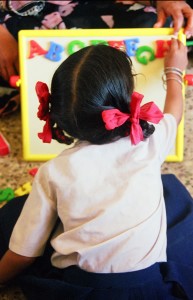Language Development
Below are the age ranges for typical developmental milestones. Click on an age range to display milestones for that time frame.
- Uses speech sounds to get attention
- Listens when spoken to
- Says 1-3 words
- Uses nouns almost exclusively
- Understands simple commands
- Says 3-20 words or more
- Produces 2-word phrases
- Follows simple commands
- Produces mostly unintelligible speech
- Combines gestures and vocalizations
- Requests more of desired items
- Uses words more frequently
- Understands 300 or more words
- Says 50-100 or more words
- Starts to combine nouns and verbs
- Begins to use pronouns (I and mine)
- Is 25-50% intelligible to strangers
- Answers “what’s that?” questions
- Enjoys listening to stories
- Knows 5 body parts
- Follows 2-part commands
- Speech is 50-70% intelligible to strangers
- Understands 500-900 or more words
- Says 50-250 or more words
- Uses 3-4 word phrases
- Asks 1-2 word questions
- Verbalizes toilet needs
- Requests items by name
- Responds to some yes/no questions
- Follows simple commands and answers simple questions
- Enjoys listening to short stories, songs, and rhymes
- Understands who, whose, and how many
- Understands most things said to him/her
- Uses vowels correctly
- Uses ‘ing,’ possessive ‘s,’ and plural ‘s’
- Speech is 80% intelligible to strangers
- Understands 1200-2000 or more words
- Says 800-1500 or more words
- Understands object function
- Understands differences in meanings (stop-go, in-on, big-little)
- Follows 2-3 step commands
- Asks and answers simple questions (who, what, where, why)
- Uses language to express emotion
- Uses 4-5 words in sentences
- Is conscious of past and future
- Appropriately uses ‘is’, ‘are’, and ‘am’ in sentences
- Uses pronouns (him, her, he, she, they etc.)
- Tells two events in chronological order
- Engages in long conversation
Typical Speech Sound Development
The following chart shows typical time frames for speech sound development. The bar begins when a child starts to produce a sound correctly and ends when 90% of typical children have mastered the sound.



